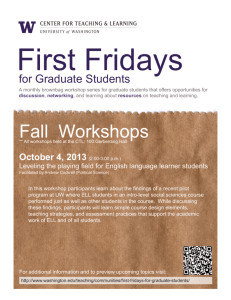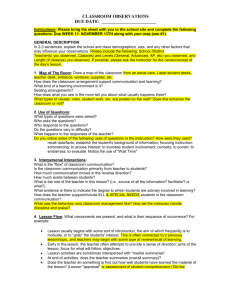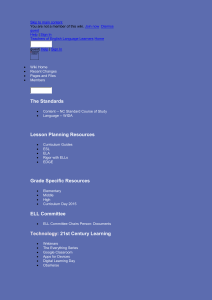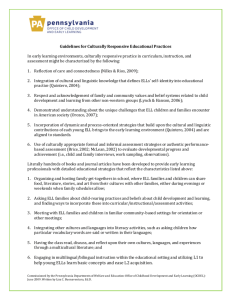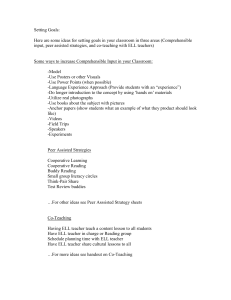Materials Evaluation
advertisement
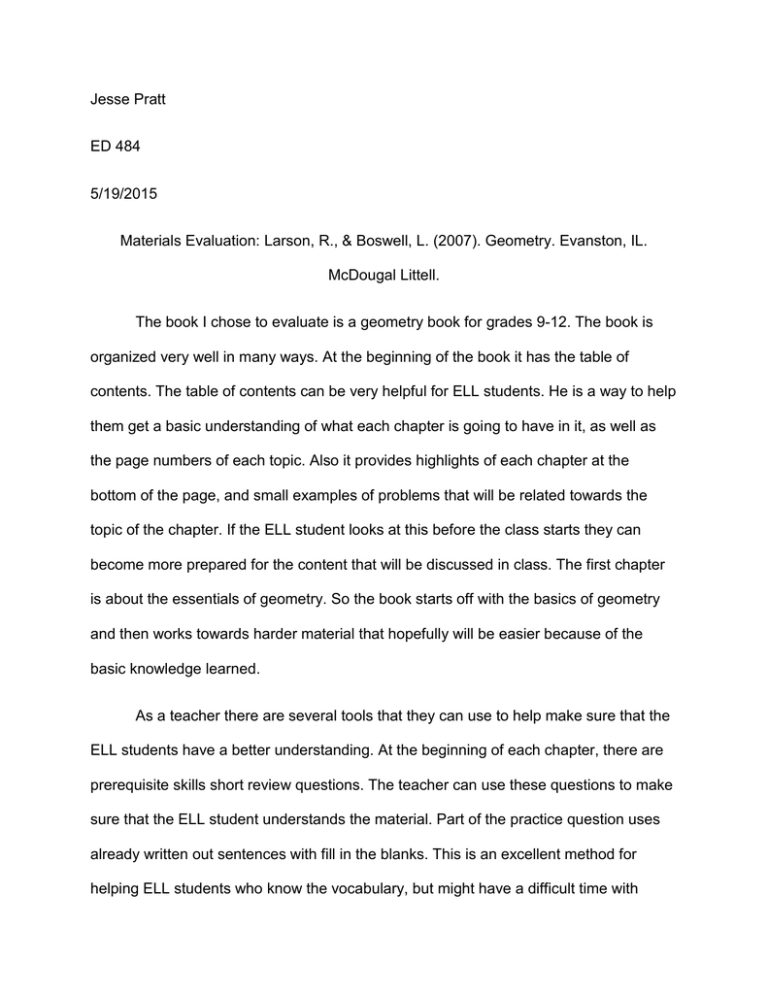
Jesse Pratt ED 484 5/19/2015 Materials Evaluation: Larson, R., & Boswell, L. (2007). Geometry. Evanston, IL. McDougal Littell. The book I chose to evaluate is a geometry book for grades 9-12. The book is organized very well in many ways. At the beginning of the book it has the table of contents. The table of contents can be very helpful for ELL students. He is a way to help them get a basic understanding of what each chapter is going to have in it, as well as the page numbers of each topic. Also it provides highlights of each chapter at the bottom of the page, and small examples of problems that will be related towards the topic of the chapter. If the ELL student looks at this before the class starts they can become more prepared for the content that will be discussed in class. The first chapter is about the essentials of geometry. So the book starts off with the basics of geometry and then works towards harder material that hopefully will be easier because of the basic knowledge learned. As a teacher there are several tools that they can use to help make sure that the ELL students have a better understanding. At the beginning of each chapter, there are prerequisite skills short review questions. The teacher can use these questions to make sure that the ELL student understands the material. Part of the practice question uses already written out sentences with fill in the blanks. This is an excellent method for helping ELL students who know the vocabulary, but might have a difficult time with sentence structure, this way their answers are more to do with their knowledge of the content rather than the use of sentence structure. The book gives key concepts and vocabulary words and the definitions, however for some ELL students understanding these definitions can be difficult. An example of a vocabulary word that a teacher might need to help an ELL student is the word plane. If an ELL student already has the word plane know for an airplane, then it might be difficult for them to read that and understand it as another definition. One way the book tries to help with this is by having pictures next to the words and their definitions. Another way that the book tries to help students to get a better understanding is that it has interactive website that has “animated geometry.” This website would be an excellent way for teachers to show the students pictures of the content words and to have better moving pictures that would be easier to see and get a better understanding of the word. Also they have another online site that is called home tutor. This can be an extremely helpful tool if the student has questions when they are at home and can’t figure out the problem. One problem that I feel that the book has, is that it could be difficult to have authentic assessments is some areas. Some of the word questions in the book are worded weirdly, and can be rather difficult for an ELL student. As a teacher I would suggest talking to your ELL student and making sure that they fully understand what the word problems are saying, and if they are having a hard time, you could rewrite the problem so that the student is able to understand. Also if the teacher notices that the student does all the math correctly, but it seems that they might have just misunderstood what the question was asking, I would give them back the assignment and talk to them about the question and work with them to have another chance at answering it correctly. Another thing that can be helpful to the students is at the back of the book it has an answer key for all of the odd numbered questions, and a student can use that to work backwards and understand how to get the answer for that question, and use it for the even numbered questions. My favorite part of this book is at the back of it, there is a Contents of Student Resources section. This has many helpful tools not just for ELL students, but for all students in general. There is a skills review handbook that not only gives examples and practices of important topics, but it also gives review definitions and formulas. It has many other skills that are important to review and are very helpful for mathematics. There is a Problem Solving Plan and Strategies section. This is very helpful to explain to students how they should start out planning on solving the problems. It is an excellent tool for when you are struggling coming up with a plan. Also the back of the book gives extra practice problems for the chapters that the students can use as extra practice. There are also examples of problems that are showing how to answer the problem with step by step to get the answer. One helpful tool for Spanish speaking learners is that the book has an EnglishSpanish Glossary. This will be very helpful for a Spanish ELL that knows most of the content words in Spanish, but have no idea what the words are in English. As a teacher if you have a student who speaks another language I would recommend trying to search for a glossary like this one in that language online. Overall I feel that this book does an alright job in having tools that will be helpful for ELL students.
